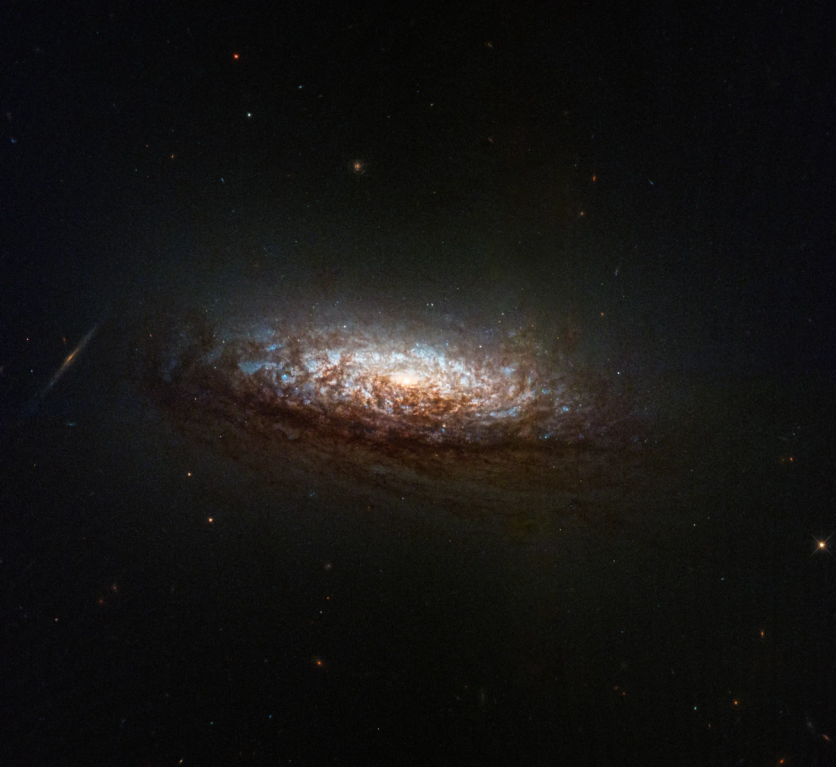NASA's Hubble Space Telescope has released its first new image following its recent switch to an alternative operational mode utilizing a single gyro.
NASA's Hubble Space Telescope Is Back On Track!
The spacecraft resumed scientific activities on June 14 after several weeks of downtime due to a malfunction in one of its gyroscopes, which was critical for maintaining its orientation and stability.
The newly captured image showcases NGC 1546, a neighboring galaxy in the Dorado constellation. The galaxy's positioning provides a unique perspective, highlighting dust lanes backlit by its core.
According to NASA, these dust lanes absorb light, casting a rusty-brown hue, while the core emits a yellowish glow from older stars. Areas of vibrant blue indicate active star formation, peeking through the dust. Additionally, several distant galaxies are visible, including a spiral galaxy alongside NGC 1546.
Hubble's Wide Field Camera 3 captured this image as part of a collaborative observational program involving NASA's James Webb Space Telescope and the Atacama Large Millimeter/Submillimeter Array. This cooperative effort aims to provide a comprehensive, multiwavelength exploration of stellar formation and evolution.
This image marks one of the initial observations made by Hubble under its new pointing mode, which enhances its operational consistency for scientific endeavors. NASA anticipates that this updated mode will enable Hubble to conduct most of its scientific observations effectively.
Dr. Jennifer Wiseman, senior project scientist for Hubble at NASA's Goddard Space Flight Center, expressed confidence in the telescope's revamped capabilities. She emphasized that Hubble is now well-positioned to embark on numerous astronomical discoveries, ranging from our solar system to exoplanets and distant galaxies.
"We're poised now for many years of discovery ahead, and we'll be looking at everything from our solar system to exoplanets to distant galaxies. Hubble plays a powerful role in NASA's astronomical toolkit," Wiseman said in a statement.
Read Also : NASA Says Hubble Space Telescope Can Still Explore Secrets of the Universe Despite Gyro Failure

A Blast From the Past
In related news, NASA's Hubble Space Telescope recently captured the enigmatic HM Sagittae (HM Sge) binary star system, shedding light on an explosive event that transpired four decades ago.
HM Sge underwent a remarkable outburst in 1975, transforming from a nondescript star into a luminous nova that typically fades over time. However, contrary to expectations, HM Sge has maintained its heightened brightness over a long period, necessitating further assessments from astronomers.
During its initial eruption phase, which spanned from April to September 1975, HM Sge demonstrated a remarkable 250-fold increase in brightness. Unlike typical novae, which usually fade rapidly after the eruption, HM Sge has maintained its luminous state, captivating astronomers with its enduring luminosity.
Latest observations have indicated a subtle dimming of HM Sge accompanied by an increase in temperature within the system. HM Sge belongs to the category of symbiotic stars, where a white dwarf and a companion giant star engage in an eccentric orbital pattern.
Learn more about this blast from the past here.
Related Article : NASA's Hubble Space Telescope Captures Mesmerizing Image of Sweeping Spiral Galaxy 43 Million Light-Years From Earth

ⓒ 2025 TECHTIMES.com All rights reserved. Do not reproduce without permission.


![Best Gaming Mouse For Gamers With Smaller Hands [2025]](https://d.techtimes.com/en/full/461466/best-gaming-mouse-gamers-smaller-hands-2025.png?w=184&h=103&f=6fd057ef777bd39251d4e7e82e9b23f1)

